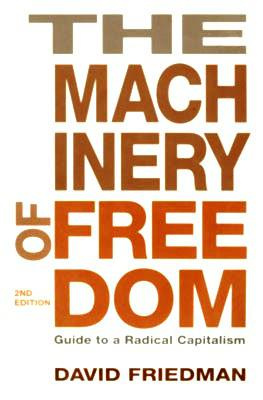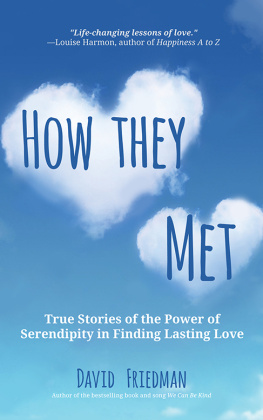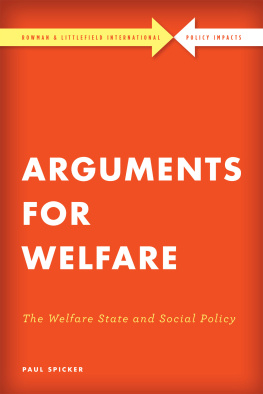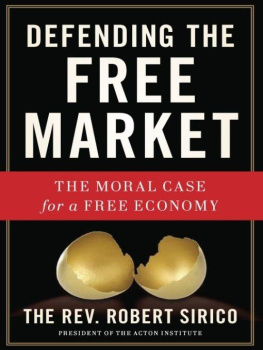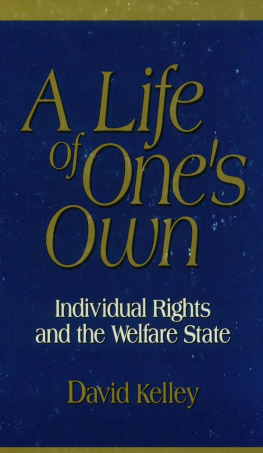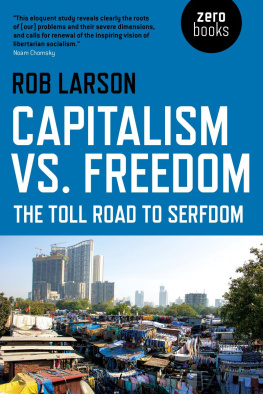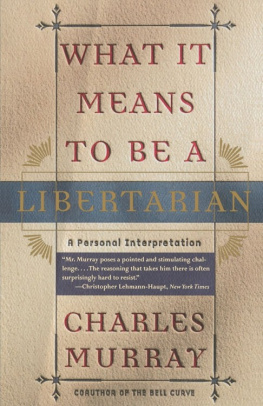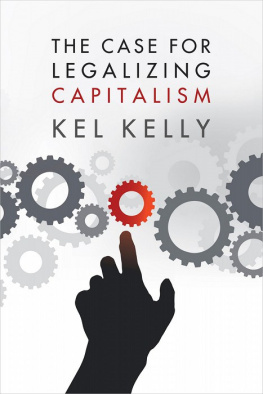The Machinery of Freedom
Guideto a Radical Capitalism
Second Edition
D avid F riedman
This book is dedicated to
MiltonFriedman
Friedrich Hayek
Robert A. Heinlein,
from whom I learned
andto
Robert M. Schuchman,
who might have written it better
Capitalism isthe best. Its free enterprise. Barter. Gimbels, if I get really rankwith the clerk, Well I dont like this, how I can resolveit? If it really gets ridiculous, I go, Frig it, man, I walk.What can this guy do at Gimbels, even if he was the president of Gimbels? Hecan always reject me from that store, but I can always go to Macys. Hecant really hurt me. Communism is like one big phone company. Governmentcontrol, man. And if I get too rank with that phone company, where can I go? Illend up like a schmuck with a dixie cup on a thread.
Lenny Bruce
Whycant you see?
We just want to be free
To have our homes and families
And live our lives as we please.
Dana Rohrabacher
West coast libertarian troubadour
CONTENTS
PREFACE TO THE SECOND EDITION
Most of thisbook was written between 1967 and 1973, when the first edition was published. Ihave made only minor changes to the existing material, in the belief that theissues and arguments have not changed substantially over the past 15 years. Insome cases the reader will find the examples dated; Chapter 17, for example,was written when Ronald Reagan was governor of California. Where this seemed tobe a serious problem I have updated examples or added explanatory comments, butin most places I have left the original text unaltered. Most current exampleswill not remain current very long; hopefully this book will outlast the presentgovernor of California as well.
I havefollowed the same policy with regard to numbers. Figures for the number ofheroin addicts in New York or U.S. Steels share of the steel industrydescribe the situation as of about 1970, when the first edition was beingwritten. When looking at such numbers, you should remember that prices andnominal incomes were about a third as high in 1970 as in 1988, when thispreface is being written. Numbers that are purely hypothetical ("If aworking wife can hire an Indian maid, who earned_______dollars a year in India"),on the other hand, have been updated to make them more plausible to a modernreader. The appendices have also been updated, mostly by my friend Jeff Hummel.
These are allminor changes. The major difference between this edition and the first is theinclusion of eight new chapters, making up Part IV of the book.
One thing Ishould perhaps have explained in my original preface, and which has puzzledsome readers since, is the apparent inconsistency among the chapters. InChapter 10, for instance, I advocate a voucher system, in which tax monies areused to subsidize schooling, but in Part III I argue for a society with notaxes, no government, and therefore no vouchers.
Part II ofthe book is intended to suggest specific reforms, within the structure of ourpresent institutions, that would produce desirable results while moving uscloser to a libertarian society. A voucher system, which moves us fromschooling paid for and produced by government to schooling paid for bygovernment but produced on a competitive market, is one such reform. In PartIII I try to describe what a full-fledged anarcho-capitalist society might looklike and how it would work. Part III describes a much more radical change fromour present institutions than Part II while Part II describes how the firststeps of that radical change might come about.
One reasonfor writing a book like this is to avoid having to explain the same set ofideas a hundred times to a hundred different people. One of the associatedrewards is discovering, years later, people who have incorporated my ideas intotheir own intellectual framework. This second edition is dedicated to one suchperson. I cannot honestly describe him as a follower or a disciple, since mostof our public encounters have been debates; I believe that his best-known viewsare wrong and possibly dangerous. He is merely someone who starts out alreadyknowing and understanding everything I had to say on the subjects of this bookas of 1973, which makes the ensuing argument very much more interesting.
For whichreason this second edition is dedicated to Jeffrey Rogers Hummel.
PREFACE TO THEFIRST EDITION
My politicalviews seem natural and obviousto me. Others find them peculiar. Theirpeculiarity consists largely of carrying certain statements, familiar enough inpolitical oratory, to their natural conclusions.
I believe, asmany say they believe, that everyone has the right to run his own lifetogo to hell in his own fashion. I conclude, as do many on the left, that allcensorship should be done away with. Also that all laws againstdrugsmarijuana, heroin, or Dr. Quacks cancer cureshould berepealed. Also laws requiring cars to have seat belts.
The right tocontrol my life does not mean the right to have anything I want free; I can dothat only by making someone else pay for what I get. Like any good rightwinger, I oppose welfare programs that support the poor with money taken byforce from the taxpayers.
I also opposetariffs, subsidies, loan guarantees, urban renewal, agricultural pricesupportsin short, all of the much more numerous programs that supportthe not-pooroften the richwith money taken by force from thetaxpayersoften the poor.
I am an AdamSmith liberal, or, in contemporary American terminology, a Goldwaterconservative. Only I carry my devotion to laissez faire further than Goldwaterdoeshow far will become clear in the following chapters. Sometimes Icall myself a Goldwater anarchist.
Thesepeculiar views of mine are not peculiar to me. If they were, I would be payingHarper and Row to publish this book, instead of Harper and Row paying me. Myviews are typical of the ideas of a small but growing group of people, a movementthat has begun to attract the attention of the national media. We callourselves libertarians.
This book isconcerned with libertarian ideas, not with a history of the libertarian movementor a description of its present condition. It is fashionable to measure theimportance of ideas by the number and violence of their adherents. That is afashion I shall not follow. If, when you finish this book, you have come toshare many of my views, you will know the most important thing about the numberof libertariansthat it is larger by one than when you started reading.
ACKNOWLEDGEMENTS
Most of thematerial in Chapters 12-15, 17-20, 22, 23, and 25 first appeared in The NewGuard in slightly different form. Most of Chapter 34 was originallypublished in The Alternative. Chapter 10 was written for the Center forIndependent Education and later published in Human Events. My thanks toall of the editors and publishers involved for permission to use the materialhere.
Chapter 38was originally published, in considerably different form, in the LibertarianConnection; since, in that peculiar journal, authors retain ownership ofwhat they write, I need not thank the editors for permission to use thematerial here. I instead thank them for generating useful ideas and maintaininga convenient and productive forum.
Chapter 47first appeared in Frontlines, vol. 2, No. 6, March 1980.
Thanks arealso due to those who read and commented on my manuscript: Emilia Nordvedt,Larry Abrams, and especially Milton Friedman. Also, for sporadic criticism andgeneral forbearance, to Diana.
INTRODUCTION
F rom Ayn Rand tobushy anarchists there is an occasional agreement on means calledlibertarianism, which is a faith in laissez-faire politics/economics Howto hate your government on principle.
Stewart Brand
The last whole earth catalog
Next page
